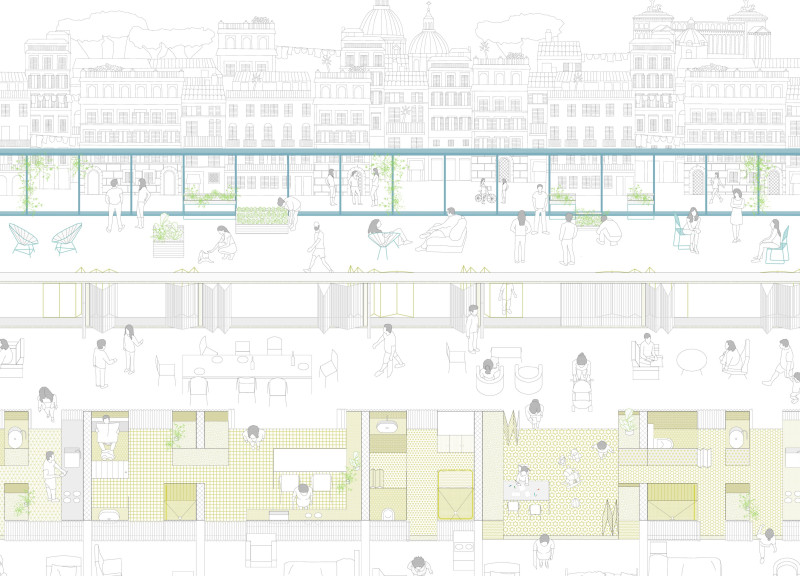Incorporating straw insulation and modular wooden units, this architectural design optimizes sustainability and flexibility to create communal living spaces that address modern urban housing needs.
5 key facts about this project
01
Incorporates straw insulation for enhanced thermal efficiency.
02
Utilizes modular wooden units for adaptable living configurations.
03
Features rainwater harvesting systems to support irrigation needs.
04
Integrates polycarbonate panels for optimal natural light.
05
Includes communal areas designed to foster resident interaction.
General keywords
Project specific keywords
This architectural design project is situated in Rome and aims to address contemporary residential challenges by merging functional living with innovative social solutions. The design integrates various living spaces that foster a balance between privacy and community interaction. It represents a forward-looking approach to urban living, emphasizing flexibility and environmental responsibility.
The project features modular units that emphasize adaptability, allowing for a reconfiguration of spaces based on resident needs. Each living unit is equipped with essential amenities while encouraging natural light and ventilation through strategic window placements. The design also promotes community interaction through shared spaces, including lounges, dining areas, and gardens, creating a cohesive living environment for residents.
Unique Adaptability and Community Interaction
What differentiates this project from many others is its inherent adaptability and focus on social dynamics. The spatial organization allows for the configuration of individual living units, which can be adjusted to accommodate varying household sizes and lifestyles. This flexibility is complemented by a strong community focus, as shared spaces are designed to encourage social engagement among residents. By integrating common areas that facilitate interaction, the project aims to foster a sense of belonging and community cohesion.
Sustainability and Materiality
Sustainability is a cornerstone of the architectural design, reflected in the choice of materials and systems incorporated into the project. The use of modular wooden structures provides both structural integrity and warmth. Straw insulation enhances thermal efficiency, while recyclable cladding materials contribute to the building’s ecological footprint. Additionally, solar panels and rainwater harvesting systems integrate renewable resources into daily living, underscoring the project’s commitment to environmental stewardship.
The architectural plans and sections provide further insight into the effectiveness of these design strategies. For a comprehensive understanding of the innovative solutions and thoughtful considerations behind this project, interested readers are encouraged to explore the complete architectural plans, sections, and various designs that showcase its unique features and functionality. Engaging with these elements will offer a more in-depth appreciation of the architectural ideas that shape this modern approach to urban living in Rome.
The project features modular units that emphasize adaptability, allowing for a reconfiguration of spaces based on resident needs. Each living unit is equipped with essential amenities while encouraging natural light and ventilation through strategic window placements. The design also promotes community interaction through shared spaces, including lounges, dining areas, and gardens, creating a cohesive living environment for residents.
Unique Adaptability and Community Interaction
What differentiates this project from many others is its inherent adaptability and focus on social dynamics. The spatial organization allows for the configuration of individual living units, which can be adjusted to accommodate varying household sizes and lifestyles. This flexibility is complemented by a strong community focus, as shared spaces are designed to encourage social engagement among residents. By integrating common areas that facilitate interaction, the project aims to foster a sense of belonging and community cohesion.
Sustainability and Materiality
Sustainability is a cornerstone of the architectural design, reflected in the choice of materials and systems incorporated into the project. The use of modular wooden structures provides both structural integrity and warmth. Straw insulation enhances thermal efficiency, while recyclable cladding materials contribute to the building’s ecological footprint. Additionally, solar panels and rainwater harvesting systems integrate renewable resources into daily living, underscoring the project’s commitment to environmental stewardship.
The architectural plans and sections provide further insight into the effectiveness of these design strategies. For a comprehensive understanding of the innovative solutions and thoughtful considerations behind this project, interested readers are encouraged to explore the complete architectural plans, sections, and various designs that showcase its unique features and functionality. Engaging with these elements will offer a more in-depth appreciation of the architectural ideas that shape this modern approach to urban living in Rome.






















